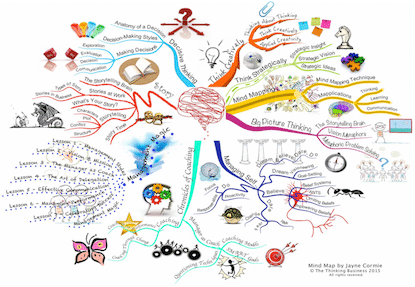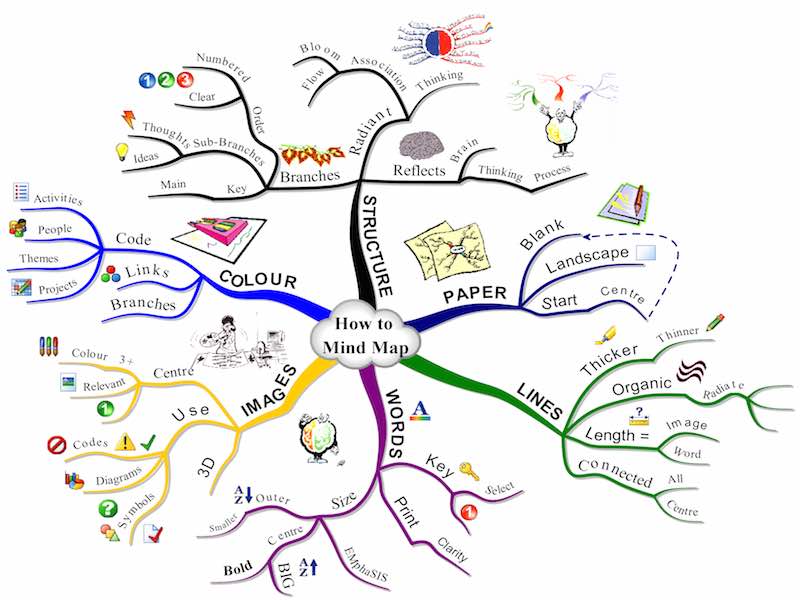Introduction to Mind Mapping
Unlock the power of your mind with a Mind Map ~ the ultimate thinking tool used to stimulate you to think, learn and communicate more effectively and efficiently.
The technique of Mind Mapping was created by Tony Buzan and is one of the most widely used thinking tools around the world. It is often called the ‘Swiss army knife for the brain’, because it is a multi-purpose thinking tool, and is already used by more than 250 million people worldwide.

What is a Mind Map?
A Mind Map® is a visual thinking tool which maps out your thoughts and ideas in a brain-friendly way using the technique of radiant thinking. It combines colour, imagery, visual-spatial skills and imagination to trigger your brain to think more creatively, learn faster, remember more and communicate better.
Mind maps can be hand-drawn or produced using mind mapping software applications.
Benefits of Mind Mapping
– Brainstorm ideas quickly and easily
– Make better decisions
– Take fast effective notes in meetings
– Make concise notes from printed material
– Prepare and present documents etc.
– Study better and remember more
– Solve problems
Uses of Mind Maps
Thinking
– Brainstorming
– Decision-making
– Project Planning
Learning
– Note-taking
– Note-making
– Studying
Communication
– Presentations
– Meetings
– Speeches
“Mind Maps are the meta-language of the human race.”
– Tony Buzan
How to Read Mind Maps
On Mind Maps, ideas and thoughts are shown as coloured images and key words branching out from a central theme. One of the key benefits of Mind Maps® is that they help you to see how ideas link to each other as well as how they relate to the central theme. Have a look at the mind map about on the right.
1. Start in the centre – the image represents the theme/topic of the Mind Map®.
2. Select one of the main branches (thick curved line connected to the central image). This has a key word printed on it and represents an idea/thought that is linked to the main theme. Think of it as being like a chapter heading in a book. Example, the ‘Lines’ branch.
3. Read out from the centre along the branch. These are second and third levels of thought with words and images that are associated with the main branch. Example, use ‘Thicker’ or ‘Thinner’ lines; draw ‘Organic’ (wavy) lines etc.
4. Continue reading around the Mind Map® until you have read and understand the whole map.
How to Make a Mind Map
1. Take a blank piece of plain paper A4 size or bigger
2. Turn the paper landscape i.e., the long side of the paper at the top
3. Draw a coloured image in the centre of the paper. This central image represents the topic of the Mind Map®
– use at least 3 colours in the image
4.Draw the main themes of the Mind Map® on thick branches radiating out from the central image
– Print the word in CAPITAL LETTERS
– place the word on a line of the same length
– make the central lines think, curved and organic (like the branch of a tree attached to the trunk)
– connected directly to the central image
5. Add other main theme branches around the map
6. Start to add a second level of thought. These words and/or images are linked to the main branch that triggered them – connecting lines are now thinner and words may be in lower case
7. Add a third or fourth level of thought as those thoughts come to you
8. Use images throughout your Mind Map®. Add an image to all the main branches to represent each key theme and also use images to visualise every important key word on your map. You can use:
– pictures
– line drawings
– patterns
– shapes
– symbols
– stick figures etc.
9. Add dimension to your Mind Map® by adding boxes and adding depth around the words and images
10. Use colours throughout the Mind Map®. be as big, bold and imaginative as possible
(Mind Maps® is a registered trademark of The Buzan Organisation)
